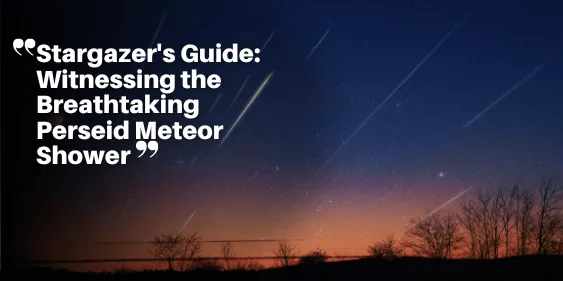Stargazer’s Guide: Witnessing the Breathtaking Perseid Meteor Shower

If you’re seeking a celestial show, the Perseid meteor shower is a must-see event.
Known as one of the best meteor showers of the year, it peaks on the night of August 11-12.
What makes this shower particularly spectacular is the potential to see up to 100 meteors per hour under ideal conditions.
During this peak period, the responsible comet particles blaze through Earth’s atmosphere, creating dazzling streaks of light visible to the naked eye.
The Perseid meteor shower provides a rare opportunity to witness numerous meteors in a short span.
Though meteors can be seen on any clear night, the frequency during this event is unmatched.
The warm weather and typically clear skies of August make this shower even more enjoyable.
Due to minimal moon interference this year, you’re more likely to see the full splendor of the Perseids.
Plan your viewing from a dark-sky location for the best experience, and bring a blanket or a reclining chair to comfortably sky-gaze for extended periods.
As Earth plows through the debris left by comet 109/P Swift-Tuttle, the small particles burn up in our atmosphere, generating the stunning meteors we call the Perseids.
This natural phenomenon not only offers a feast for the eyes but also a chance to connect with the cosmos.
Without further ado, get ready to dive into the science behind this mesmerizing display.
The Science Behind the Shower
The Perseid meteor shower, one of the most anticipated celestial events of the year, owes its splendor to the comet 109/P Swift-Tuttle.
As Earth journeys through the debris left by this comet, tiny particles burn up in the atmosphere, creating spectacular streaks of light.
Origin of the Particles
Comet 109/P Swift-Tuttle, discovered in 1862, passes through the inner solar system every 133 years.
As it nears the Sun, the comet sheds debris in its wake.
When our planet intersects this debris field each year, these ancient particles, some no larger than grains of sand, collide with Earth’s atmosphere at high speeds.
The Process of Meteor Formation
As these particles enter our atmosphere, they encounter intense friction.
This friction generates heat, causing the particles to glow brightly and vaporize almost instantaneously.
The result is the brilliant meteors, or “shooting stars,” that light up the night sky.
The Perseids are particularly known for producing bright meteors and frequent fireballs, making them a favorite among stargazers.
The Radiant Point
Like all meteor showers, the Perseids are named after the constellation from which they appear to emanate, or their “radiant point.”
In this case, the meteors seem to originate from Perseus, which rises in the east around 10 p.m. local time.
However, the meteors can be seen streaking across various parts of the sky, not just near Perseus.
Understanding the science behind the Perseid meteor shower adds a layer of appreciation to the experience.
As you prepare for this celestial show, remember that each meteor you see is a tiny fragment of a comet, a brief visitor from the depths of space.
Optimal Viewing Conditions
Minimal Moon Interference
One of the major factors contributing to a great meteor shower experience is the phase of the moon.
This year, stargazers are in luck! The moon will be a quarter full and will set after 1 a.m. local time, leaving plenty of dark skies for observing the Perseids.
This minimal interference from lunar light makes for an unobstructed view of the meteors streaking across the night sky—a treat for both seasoned and novice stargazers.
The Importance of Dark-Sky Locations
For the best viewing experience, it is essential to find a location with minimal light pollution.
Dark-sky locations, away from the bright lights of cities and towns, offer the clearest views.
If heading to a dedicated dark-sky park isn’t feasible, local parks or any low light pollution areas will suffice.
Patience is key, as it may take some time for your eyes to fully adjust to the darkness.
Enhancing Your Experience
The Perseid Meteor Shower takes place under typically warm August weather, which is a boon for extended observation sessions.
Clear skies with minimal cloud cover are another favorable condition.
Make your viewing even more comfortable with a reclining chair or blanket.
Dress in layers to stay warm, as it can get chilly during the early morning hours when the best views are often had.
Staying informed about weather forecasts can also optimize your stargazing experience.
While the meteor shower peaks on the night of August 11-12, meteors remain visible in the surrounding days, providing several opportunities for clear skies.
Meteor showers like the Perseids are moments to marvel at our universe, an experience made more magical under ideal viewing conditions.
When and Where to Look
The Perseid Meteor Shower reaches its dazzling peak on the night of August 11-12.
However, don’t be dissuaded if you miss this exact window; the meteors are also observable in the days before and after the peak.
Around 10 p.m. local time, you’ll find the constellation Perseus rising in the eastern sky.
Although it’s named after this constellation, the meteors will generally appear all around the sky, giving you a spectacular 360-degree show.
To maximize your viewing experience, aim to be in place before 10 p.m. and stay until dawn.
As the Perseids are often bright and sometimes produce fireballs, you won’t know where the next streak of light will appear, so keep scanning the whole sky.
The best way to observe them is by lying on a blanket or reclining chair, which allows for a wide field of view.
Remember, patience is key. Stay focused on the sky for an extended period to increase your chances of catching the most meteors.
This year, with the moon setting around 1 a.m. local time, dark skies will provide perfect conditions for viewing the spectacle.
Get comfortable, stay alert, and prepare for one of the most awe-inspiring celestial events of the year.
What to Expect
Bright Meteors and Frequent Fireballs
When the Perseid meteor shower hits its peak on the night of August 11-12, prepare yourself for a dazzling display.
You can expect bright meteors that can streak across the sky in vivid bursts of light.
Adding to the spectacle, the Perseids are known for frequent fireballs, which are larger explosions of light and color that can persist longer than an average meteor.
These fireballs are typically brighter and can even outshine Venus, making them a favorite among skywatchers.
Possibility of Increased Activity on August 12-13
The Perseid meteor shower can also show peak activity on the night of August 12-13.
Experts suggest this may happen due to Earth’s passage through denser streams of comet debris.
With skies remaining dark and the moon setting early, the conditions are ripe for an extended showcase of shooting stars.
This means you’ll have a second chance to witness a potentially increased number of meteors per hour, making it worth watching on both nights.
Potential for Auroras Due to Recent Solar Activity
Another thrilling aspect to anticipate is the potential for auroras.
Recent solar activity has been high, which could enhance auroral displays. So, while you’re out enjoying the meteor shower, keep an eye out for shimmering auroras dancing across the horizon.
These natural light shows, combined with the Perseid meteors, can make for an unprecedented stargazing experience.
Grab your blanket, find a cozy spot with minimal light pollution, and immerse yourself in this celestial spectacle.
Tips for Stargazers
Find a Location with Low Light Pollution
For a front-row seat to the Perseid meteor shower, finding a location with minimal light pollution is key.
City lights can drown out even the brightest meteors, so aim to venture out to a park or a dedicated dark-sky site.
These remote viewing spots offer the best chance to witness up to 100 meteors per hour on peak nights, ensuring an unobstructed, awe-inspiring view of the celestial spectacle.
Be Patient and Keep Looking Up
Patience is essential when it comes to stargazing. While the Perseid meteor shower promises numerous meteors, they won’t all come at once.
Plan to spend a few hours outside for the best chance to catch multiple meteors and occasional fireballs lighting up the sky.
Bring a reclining chair or blanket to lie down on and keep your eyes on the sky, allowing them to adjust to the darkness.
No Special Equipment Needed
One of the most appealing aspects of the Perseid meteor shower is that it requires no special equipment.
You don’t need telescopes or binoculars to enjoy the show. Your eyes are your best tool for appreciating the full scope of meteors streaking across the sky.
Just find a comfortable spot, relax, and let the night sky dazzle you.
With these tips in mind, you’re well-prepared to make the most of this year’s Perseid meteor shower.
Gather your friends and family, and get ready to be amazed by this natural light show.






